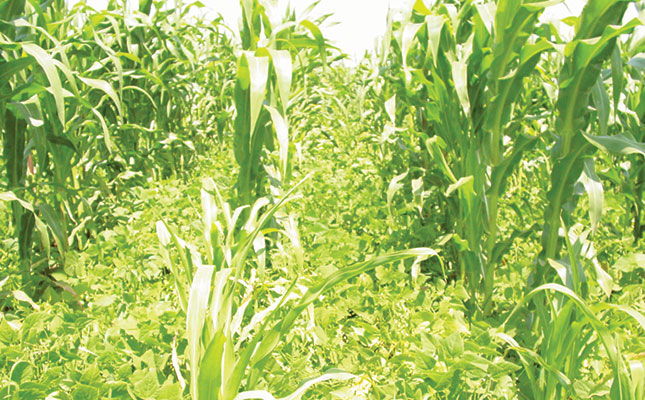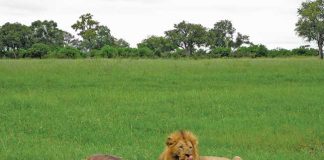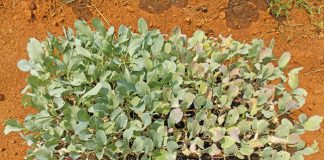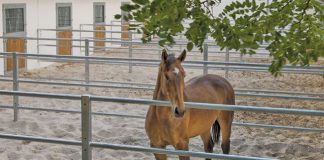
Photo: Prof Chris Dannhauser
While crop rotation may not be a new practice, have you considered including seasonal pastures in your cash crop system?
Prof Chris Dannhauser, a grazing specialist from Limpopo, says the ley cropping system, in which a grass/legume mixture is grown in rotation with agricultural crops, starts with the planting of maize every second year, and annual ley crops in the alternate years.
“In this system, perennial pastures can also be utilised in years two and four, between maize production years,” he adds.
The important question every farmer should ask is this: which pasture species can be used for this system on my farm?
“It’s important for the species and cultivars used as ley pasture crops to have specific characteristics,” says Dannhauser.
Ley crops have two functions: to serve as good-quality animal feed, and to improve soil quality and fertility for the grain crops that will follow. Knowledge of the impact that a specific ley crop will have on soil and nutrition is therefore crucial to success.
“Some ley pasture crops will aid soil carbon build-up and supply organic matter,” explains Dannhauser.
Initially, the grass will produce oxygen. Animals graze the grass, and this leads to the dung they produce, the plant roots and residues, and the micro-organisms in the soil creating organic material and carbon, which feed the soil. Some examples of ley crops that excel in these situations are:
Summer annuals: babala/pearl millet (Pennisetum glaucum) and forage sorghum;
Winter annuals: cereal rye (Secale cereale), stooling rye (S. cereale L.), annual ryegrass (Lolium multiflorum), triticale (×Triticosecale), oats (Avena sativa), wheat (Triticum aestivum), spelt (T. spelta), and barley (Hordeum vulgare); and
Perennials: tropical grasses, particularly Rhodes grass (Chloris gayana) for its ability to control nematodes.
“Organic material is very important for improving soil structure, water infiltration and plant root development,” says Dannhauser.
Pasture crops that increase the soil’s nitrogen content are ideal for this, and farmers should consider the following options:
Summer annuals: cowpea (Vigna unguiculata), mung bean (V. radiata), soya bean (Glycine max), dolichos bean (Lablab purpureus), velvet bean (Mucuna pruriens), sunn hemp (Crotalaria juncea) and jack bean (Canavalia ensiformis);
Winter annuals: winter pea (Pisum sativum L.), red clover (Trifolium pratense), sweet clover (Melilotus), vetch (Vicia) and serradella (Ornithopus sativus); and
Perennials: lucerne (Medicago sativa) and poor man’s lucerne (Lespedeza cuneata).
Benefits of ley crops
Dannhauser says all legumes can provide nitrogen supplementation. “In general, legumes need phosphorus for nitrogen fixation, but are poor scavengers of it in the soil.”
He adds that legumes acidify the soil, which tends to make phosphorus less available to them. To combat this, farmers should plant more grass crops.
“In large part, grass cover crops store and supply more phosphorus than legumes do because they have finer root systems and cover a greater surface area than legumes with their taproot [systems].”
In a mixed legume/grass pasture, the legume cycles nitrogen to the grass and the grass cycles phosphorus to the legume. The use of grass in a rotational system can also limit soil erosion, he explains, adding that grasses have fibrous root systems to bind soil.
Some of the best grass cover crops are babala, forage sorghum, cereal rye, annual ryegrass, oats, wheat and barley. Other options include dolichos bean, cowpea, winter pea and Rhodes grass.
Fodder crops can also be used as natural herbicides and for weed suppression due to their allelopathic effects. The best varieties for these purposes are stooling rye, oilseed or tillage radish (Raphanus sativus), oats, barley, pearl millet and forage sorghum. Annual ryegrass, cereal rye and sorghum may be used for controlling soya bean cyst nematodes.
In wetter regions, farmers might want to consider crops that can tolerate wet soils, such as sweet and red clover, annual ryegrass, cereal rye, wheat and oats.
“If a producer is looking for a crop that can tolerate soil salinity and control nematodes, he or she can consider Rhodes grass,” adds Dannhauser.
Those farmers who require heat-and drought-tolerant crops can look at dolichos bean, cowpea, hairy vetch (Vicia villosa), mung bean, sweet clover, sorghum, pearl millet, buckwheat (Fagopyrum esculentum), barley and teff (Eragrostis tef).
Varieties tolerant of cold conditions include cereal rye, oats, wheat, spelt, triticale, winter pea and sweet clover.
Seasonal ley crops
Annual winter-growing grasses that farmers can plant after maize include oats, stooling rye and triticale, as well as root crops such as Japanese radish (R. sativus var. Longipinnatus), forage rape (Brassica napus) and turnip (B. rapa subsp. rapa).
“They can be planted in autumn and early winter, in high rainfall areas or under irrigation, and can be grazed in winter and spring,” notes Dannhauser.
When it comes to summer ley crops, he says that Japanese radish, fodder turnips and forage rape maximise root growth.
“These pastures should preferably be grazed twice in the growing season, once in early summer, as root growth increases naturally after the first grazing, and again in late summer to boost organic matter decomposition.”
These crops are also effective in the recycling of nutrients, the reduction of soil compaction, and the promotion of weed suppression.
Conventional ley crops
Fodder sorghum is adapted to most soils and grows well in areas with annual rainfall of 500mm and above, advises Dannhauser. It grows everywhere in South Africa, except the dry Karoo and northern region of the Western Cape, where it needs irrigation. “It can be used as green grazing, green chop, hay, foggage and silage,” he adds.
It can be sown from October in warm areas and November/December in cooler areas, and requires medium to high levels of fertilisation. Three to four cuttings or grazing cycles are possible.
“Start grazing with sheep when the grass reaches a height of 50cm, and with cattle when it reaches 70cm to 100cm,” recommends Dannhauser.
Hybrid pearl millet is a drought-resistant annual fodder crop and is adapted to most areas of South Africa with annual rainfall of more than 400mm. It can be used as green grazing, hay and foggage.
Recently, new hybrid cultivars with higher production levels and better characteristics have been introduced, including Hypearl Millet, Speedfeed, Milkstar, Nutrifeed and Hypearl Millet BMR. “Combined with annual legumes like dolichos and cowpea, it produces good forage,” says Dannhauser.
The annual winter cereals used for fodder crops are oats, stooling rye and triticale. Most cultivars will grow in areas with annual rainfall of greater than 650mm, especially when some of this rain falls during March/April. “It’s important to plant on soils with good moisture-holding capacity,” says Dannhauser.
These winter fodder crops can be divided into two groups according to their growth habits: short- and long-duration types.
Dannhauser recommends the use of the following annual winter grasses in early winter: LS 35, Henoch, SSR 727 and stooling rye cultivars, as well as the oats cultivars Overberg, Cederberg and SSH 421.
During the late winter, producers can consider planting Agriblue, SSR 729, LS 62 and stooling rye, as well as Drakensberg, SWK 001 and Witteberg oats.
Alternative crops
Non-traditional crops, such as Brassica species (fodder kale, fodder rape, swede and turnip), have also recently become very popular. Dannhauser says that their appeal in terms of forage production lies in the fact that they can even be planted in low-quality soils.
The most sought-after of these is the Nooitgedacht cultivar of Japanese radish, a high-yielding crop that requires relatively few management inputs. “Yields of up to 10t of dry matter (DM)/ha under dryland [farming] and up to 15t DM/ha under irrigation are possible.”
Japanese radish is important in fodder flow programmes as an autumn and winter fodder crop, especially in the cooler Highveld area, says Dannhauser.
Fodder turnips have large bulbous or tapered roots, of which a large part is exposed above soil and is available to grazing animals. The succulent, carbohydrate-rich foliage can be grazed for at least two cycles, first to utilise the leaves, and later to take advantage of both the leaves and roots. “The two most popular [fodder turnip] cultivars are Mammoth Purple Top and Green Globe.”
Dolichos bean is adapted to warm, humid climates with an annual rainfall of 450mm to 900mm. It can grow in a variety of soil types, as long as the soil is well drained. It also tolerates cool temperatures; however, it is sensitive to frost.
For fodder and grazing, dolichos can be planted in rows during October/November.
“Inoculating [dolichos seed] with cowpea rhizobium is important,” stresses Dannhauser.
Cowpea is a summer crop that is adapted to hot, dry conditions, and grows in most areas where maize is produced. However, it can also be grown successfully in acidic and low-fertility soils.
It typically has trailing, climbing stems, large leaves and curved pods. Wide genetic diversity occurs, with specific cultivars for forage and grain.
“Phosphorus application is important [for cowpea production], as is inoculation,” says Dannhauser. Cowpea can be used as grazing, hay and silage, and “combines well with fodder sorghum and pearl millet”.
Soya bean is adapted to the main grain-producing areas in South Africa, where conditions are warm to hot and annual rainfall measures 500mm or more.
It can be planted in spring or early summer, and is usually planted in pure stands. However, it can be mixed with annual grasses to produce grazing, hay or silage. It is sensitive to weed competition, and inoculation is necessary if the land was not previously planted to soya bean.
Email Prof Chris Dannhauser at [email protected].











